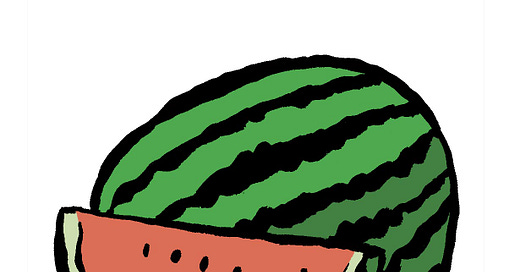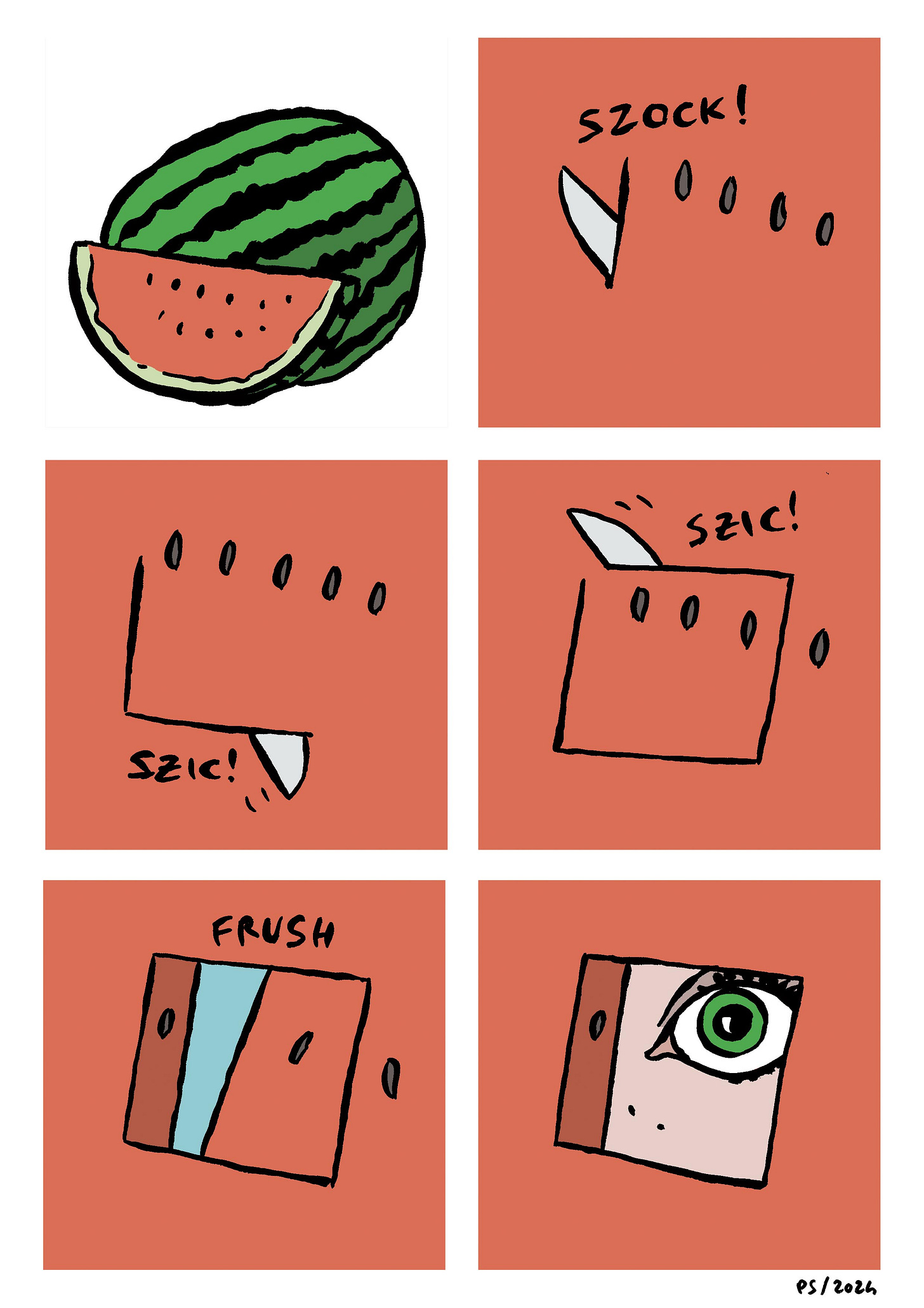(scroll down for English version)
Il citrullus lanatus, anche detto cocomero, anguria o melone d’acqua. È originario dell’Africa tropicale ma oggi si coltiva un po’ dappertutto lungo la zona temperata che va dalla Cina al Messico. La sua pianta può produrre anche centro frutti. Nella storia dell’arte lo si trova in tantissime nature morte, direi a partire dal ‘600. Tra gli altri, lo hanno dipinto Giovanni Segantini, Paul Cézanne, Henri Matisse, Umberto Boccioni, Giacomo Balla, Pablo Picasso, Salvador Dalí, ognuno a suo modo (le loro opere le trovate raccolte qui).
I cocomeri, in spagnolo sandías, sono stati l’ultimo soggetto dipinto sia da Frida Kahlo, in Viva la Vida (1954), sia da suo marito Diego Rivera, in Las Sandías (1957). Sono quindi un simbolo di ricchezza e di vita. In effetti sono stati trovati anche nelle tombe dei faraoni dell’antico Egitto e in Messico si usano per il giorno dei morti.
Di recente lo si trova anche in forma di emoji: i suoi colori - verde, rosso, bianco e nero per i semi - sono gli stessi della bandiera palestinese, così il cocomero viene usato per aggirare le restrizioni sui social network… ma anche in questo caso l’idea di usare una fetta di cocomero come bandiera ha le sue radici nell’arte, come si spiega in questo articolo de Il Post. Dalla Guerra dei sei giorni (1967) fino agli accordi di Oslo (1993) Israele impediva nei fatti di esporre la bandiera palestinese a Gaza e nella West Bank. Ma anche i colori della bandiera erano proibiti, come scoprì nel 1980 un gruppo di artisti palestinesi, quando i militari israeliani chiusero una loro mostra perché le opere avevano colori troppo simili a quelli della bandiera: “Anche se dipingeste un cocomero, verrebbe confiscato”, disse loro uno dei militari. Qualche anno fa, nel 2007, un altro artista palestinese, Khaled Hourani, si è ispirato a questa storia e ha recuperato l’idea della bandiera/cocomero.
Ma io non sapevo nulla della potenza simbolica del cocomero quando ho disegnato la sequenza qui sopra. Si basa semplicemente su un ricordo di me ragazzino, quando a volte incidevo piccole finestre in una fetta di cocomero, prima di mangiarla.
Watermelons
The scientific name for the watermelon is Citrillus lanatus. It sounds very funny in Italian, because the word citrullo means something like stupid, dumb, not very smart. It really doesn’t do justice to this fruit and its rich and old relationship with human beings: it has been found in the tombs of the Pharaos of ancient Egypt and today is displayed in Mexico during the Day of the deaths.
In the history of art, watermelons have often been painted in still lifes, at least since 17th century. Among the others, watermelons have been portrayed by Giovanni Segantini, Paul Cézanne, Henri Matisse, Umberto Boccioni, Giacomo Balla, Pablo Picasso, Salvador Dalí, each one in their own personal way. A group of watermelons is the subject of the last painting by Frida Kahlo, called Viva la vida (1954). A few years later his husband, the Mexican artist Diego Rivera, did the same thing and painted watermelons in his last work, called Las sandías (1957).
These days it’s easy to find a watermelon used in the form of an emoji. Its colors - green, red, white and black - are the same of the Palestinian flag, and posting a watermelon is a way to bypass restrictions on social network… but even this use has roots in art. For many years - from the Six-day war in 1967 to the Oslo accords in 1993 - public displays of the Palestinian flag were outlawed in Gaza and in the West Bank. But it wasn’t just the flag, even its colors were banned, as a group of Palestinian artists discovered in 1980, when the Israel military shut down their exhibition. One of those artists, Sliman Mansour, told The Atlantic what an officer said then: “Even if you paint a watermelon, it will be confiscated”. Many years later, in 2007, another Palestinian artist, Khaled Hourani, was inspired by this story and recovered the idea of the watermelon/flag.
But I didn’t know any of this when I drew the sequence above: it’s just a memory from my boyhood, when sometimes I used to cut a window in a watermelon’s slice, before eating it.






100 frutti?? Caspita! Io però non ho mai visto una pianta di cocomero, solo i frutti. E se li incidevo, be', era per mangiarmeli 😋...